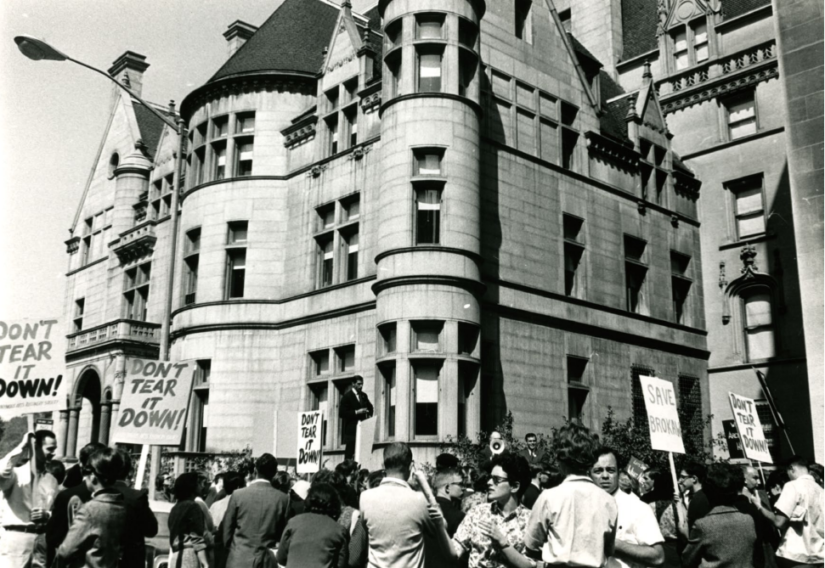
Anthony Campagna
Anthony Campagna was a developer responsible for the demolition of Greenwich Village’s “House of Genius” and the Brokaw Mansion.
Anthony Campagna was a prominent developer and member of the Board of Education in New York City. He was born in Castelmezzo, Italy in 1885. Although his father was a builder, Campagna decided to pursue a career in law. In 1906, he graduated from law school at the University of Naples.1
Shortly after graduating, he moved to Chicago to work with a friend on an Italian language newspaper. On a visit to New York City he met with several builders, which inspired him to move to New York and change his profession. He formed the company Campagna Construction, and was responsible for building the luxury apartments at 960 Fifth Avenue, 35 and 530 Park Avenue, and the Rialto on 42nd Street and Broadway.2
Anthony Campagna was also a Bronx member of the Board of Education. He served as chairman on the Committee of Building and Sites in the 1940s. He directed a $100 million program to construct schools. In addition, he was the founder of the Casa Italiana at Columbia University. He traveled back to Italy and helped restore Virgil’s Tomb in Naples and a Roman tower in Minturo. Anthony Campagna passed away at the age of 84 in 1969.3
Anthony Campagna’s planned demolition of the “House of Genius” in Greenwich Village ignited a preservation battle to preserve this collection of row houses. In the 1940s, Anthony Campagna had bought up the "Genius Row" houses at Washington Square Park South between West Broadway and Thompson Street. His plan was to demolish these historic structures in order to build three high-rise apartment houses with 302 family units.4 The "House of Genius," a row house on the block Campagna purchased, had served as a cultural and artistic landmark for Greenwich Village residents. Originally a single-family dwelling, it was converted into a boarding house by Swiss-born Mme. Branchard. Branchard exclusively rented to writers, artists, and musicians.5 Many notable guests passed through the "House of Genius" including Willa Cather, Frank Norris, and Alan Seeger.
Community organizers sought to protect "Genius Row" by trying to designate it as a National Historic Landmark as well as illustrating how it could be converted into an art center.6 Yet, they were unable to secure the funds for this conversion. Furthermore, Anthony Campagna was awarded eviction certificates from the City to displace the 50 families who inhabited the row houses.7 Campagna demolished the row of buildings in the summer of 1948. However he decided against the proposed apartment development and sold the property to New York University. Since he was a member of the Board of Education he reasoned the sale was for "a development of more importance to the civic and cultural life of the city.”8
Years later, Anthony Campagna’s planned demolition of the Brokaw Mansion sparked an active movement to preserve these mansions. The Brokaw Mansion was built in the late 1800s and modeled after the 16th century Chateau Chenonceaux in the Loire Valley of France.9 In the mid-1940s the mansions were used as the headquarters for the Institute of Radio Engineers. Campagna Construction Corp. bought the property in 1963 and announced plans for demolition on September 17, 1964.10
Contemporaneous to this time was the special committee Mayor Robert F. Wagner, Jr. formed to address the issue of safeguarding historic structures. This committee, later known as the New York City Landmarks Preservation Commission, had drawn up a list of buildings that were architecturally and historically significant and therefore worthy of protection. The Brokaw Mansion had been listed on September 23, 1962, however the Commission had no legal authority to protect the mansions from demolition.11 The Commission had drafted legislation, the New York City Landmarks Law, which had passed by city council and was awaiting Wagner's signature. Ironically Mayor Wagner declared the week of September 28-October 4, 1964 “American Landmarks Preservation Week in New York City,” as the fate of the mansions remained tenuous.12 In an urgent telegram to the mayor, the Municipal Art Society, the American Institute of Architects, the Architectural League, and the Fine Arts Federation pressed the mayor to sign the Landmarks Law in order to protect the Brokaw Mansion.13 The battle was lost when the mansion was demolished on February 6, 1965. A year later, Campagna had built a 26-story cooperative apartment building. However, this event only fueled the fire for the preservationist movement to get the New York City Landmarks Law passed.
- ”Anthony Campagna Dies at 84; Led School Building Program,” The New York Times, 9 May 1969.
- Ibid.
- Ibid.
- ”Villagers Strive to Save Landmark,” The New York Times, 13 December 1947.
- ”Mme. Branchard of ‘Village Dead,” The New York Times, 10 January 1937.
- ”Villagers Strive to Save Landmark,” The New York Times, 13 December 1947.
- ”Village Evictions Ordered by Court,” The New York Times, 24 January 1948.
- Lee E. Cooper, “‘Genius Row’ Sale to N.Y.U. By Builder Arouses Village,” The New York Times, 16 July 1948.
- John Freeman Gill, “Goodbye to All That,” The New York Times, 3 April 2005.
- Anthony C. Wood, Preserving New York: Winning the Right to Protect a City’s Landmarks (New York: Routlege, 2008), pages 1-2, and 19: endnote 3.
- Ibid, page 333.
- Ibid, page 333.
- Ibid, page 333.




